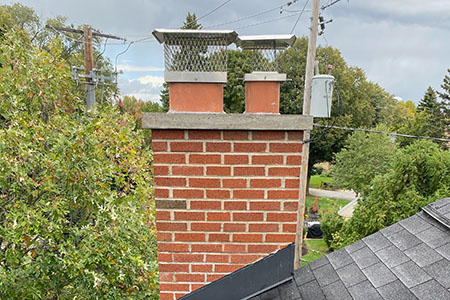Chimney Caps
 Your chimney rain cap, also known as a spark arrestor, serves multiple purposes. From preventing rain and snow from entering your chimney flue system, to keeping raccoons, birds, and other critters out of your chimney. Not only do they prevent debris and pests from entering your chimney, they help prevent sparks from exiting at the top of the chimney which can cause a potential for fire at the roof level. The type of fireplace and your chimney structure will determine the rain cap that your chimney will require.
Your chimney rain cap, also known as a spark arrestor, serves multiple purposes. From preventing rain and snow from entering your chimney flue system, to keeping raccoons, birds, and other critters out of your chimney. Not only do they prevent debris and pests from entering your chimney, they help prevent sparks from exiting at the top of the chimney which can cause a potential for fire at the roof level. The type of fireplace and your chimney structure will determine the rain cap that your chimney will require.
Standard Stainless Steel Rain Cap:
Masonry fireplace and chimneys generally require a standard rain cap to be installed on top of a clay flue tile. Here at Pratt’s, we install stainless steel to mitigate any potential for rust and to provide the sturdiest material available. All of our chimney caps include animal screening when manufactured to help prevent animals and debris from entering the flue system.
Prefabricated Fireplace or Insert Rain Caps:
When you have a prefabricated, factory built fireplace, or insert, the cap your system requires is specific to the fireplace itself. At the time of your appointment, we generally will take the make/model of your fireplace and source your chimney cap with the information provided. In the chance the rain cap is no longer available, and we are unable to install an after-market rain cap, we will be happy to discuss any further options you may have.
Multi-Flue Chimney Caps:
When you have multiple flues venting from the same masonry chimney, there is generally an option to install a multi-flue cap. It is a single cap that covers all of the venting flues and can even wrap around the entire chimney crown if desired. These multi-flue caps come in a variety of design and material options, allowing you to maintain a classic chimney cap look or venture into a more decorative appearance. We offer these caps in stainless steel, copper, or powder coated to match the home.
Appliance Flue or B-Vent Caps:
Much like your fireplace, your appliance flue requires a chimney cap as well. The ventilation of the appliances out of the roofline or chimney will determine the cap required for installation.
I Am Hearing Animals In My Chimney - Now What?
It is not uncommon for us to receive animal calls, especially in the spring and fall. Raccoons, squirrels, and birds love to use uncapped chimneys as nesting areas to raise their young. While no one particularly wants to listen to the noises and risk of these animals potentially entering their home, having these critters nest in your chimney can cause a health risk as well. It is important that, once the animals are removed the chimney, it is thoroughly cleaned and capped to prevent the animals from returning. There are instances where we do have to let the animals continue to nest in the chimney, until their young are able to leave on their own. The most common scenario is when there are birds nesting in the chimney called chimney swifts.
Chimney swifts are native birds that come by their name, honestly. These small gray birds find the interior walls of masonry chimneys the most ideal place to build their nests. Chimney swifts are a federally protected migratory bird. This means any active nests with eggs or babies, we are unable to remove or cap off the flue. We have to allow the babies to hatch and fly away on their own before we are able to clean the flue and install a chimney cap.

